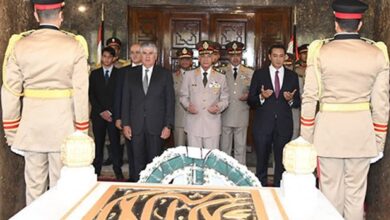
One might not agree with Hazem Kandil’s “Soldiers, Spies and Statesmen: Egypt’s Road to Revolt” that the competing roles of the military and security apparatus have been some of the main agents and causes for change in Egypt.
But as a lecturer on revolution, wars and militarism at Cambridge University, Kandil provides in his book a compelling case that in the upper echelons of corporeal, regime-forming power has been a tug of war between these “centers of power.”
The power of statesmen and civilians, on the other hand — though very real — tends to take form vis-a-vis one of its armed counterparts.
The focus of the book, as its subtitle suggests, is to explain the power changes from the 25 January revolution within this context. Kandil would agree with many that the regime has essentially not changed, and that there is a “deep state” behind the scenes manipulating events and politics.
However, the book’s main point of contention is that while people become mobilized, their power is still mostly secondary — that in the end, the revolution created a political vacuum that would only be filled by the easily co-opted.
“The only real game-changer is that [of] the empowerment of the people,” Kandil said.
The book focuses on the direction and potentials of the power struggles, how the many protracted power plays by the military and the police occurred in a race to see who would retain supremacy. Kandil describes a politically naive military that saw an opportunity to regain supremacy after being weakened during the Hosni Mubarak years in favor of a police apparatus that had become the main and only guarantor of power.
As for the police, Kandil portrays them as an entity separate from power that was momentarily defeated on 28 January 2011. It was, however, sufficiently empowered previously to be able to weather the storm and eventually re-emerge intact and again in a position of absolute power.
They are essentially two states within a state that have been in a constant strategic battle — the 25 January uprising being its latest chapter.
The rise of the Brotherhood and the role of the post-revolutionary parliamentary elections, according to Kandil, are more or less a subplot to the military-security rivalry. And his book gives a sense that it would ultimately be an insignificant one in the grand scheme of things.
Kandil uses the protests and manifestations since the 18 days in January to show how the civilian population was in constant limbo, not knowing who to trust. During the 18 days, the people’s fight was initially against the security apparatus and Mubarak regime. Chants of “the people and the military are one hand” gradually shifted, however, to “the police and the military are one hand,” and “down with military rule.”
Whether or not one agrees with his present outlook, what Kandil expertly does in the book is provide a profound historical account and analysis of the formation of these centers of power looking back from the time of former President Gamal Abdel Nasser until the present day. It is the only way one can truly understand the present position of military and security forces. And Kandil does a fantastic job in providing a well-researched and contextual text.
“I had offers from other publishers to do this book, but most of them were only interested in publishing the present day situation. I chose Verso because they were the only ones interested in the history that led to today,” Kandil said.
The book’s 20-page bibliography is evidence that as a historian, he left no rock unturned in an attempt to make sense of this relationship. The 1952 revolution was initially an attempt at mass military reformation by the Free Officers Movement. In time, the rifts within the Free Officers, especially between the charismatic President and the chronically militarily inept but politically savvy Chief of Staff Abdel Hakim Amer planted the seeds of discord between political power and the military.
The growing role of officers such as Zakariya Mohy Eddin and a coterie of officers-turned-security men during the same period in the late 1960s played to counter both civilian and military dissent, essentially forming the security apparatus that would grow in stature progressively until Mubarak’s term.
And just like the Nasser-Amer feud, former President Anwar Sadat and Mubarak had major run-ins and essential victories over two other wildly popular chiefs of staff who threatened the less-popular president’s grip on power. The former had to subdue 1973 war hero Saad Eddin al-Shazly, and appointed him ambassador to Britain. The latter accused Abdel Halim Abu Ghazala of smuggling weapon parts from the US, and also implicated him in a sex scandal in the early 1990’s.
Many saw Abu Ghazala as the only man popular enough to run against Mubarak in the 2005 presidential elections. He never did, and eventually laid low until his death in 2008.
Kandil lays down in detail how after the 1967 defeat dealt a major blow to the military’s morale, Nasser and then Sadat were able to wriggle power away from the generals. Even after the 1973 Suez war, which was viewed as a victory in Egypt, Sadat still sidelined many of his former colleagues in the military and established the tradition of offering exorbitant perks to security men who helped him maintain his power.
Essentially, Egypt under Sadat and moving onto Mubarak became neutralized to any external enemy or threat that would have empowered the military. It thus moved to combating “the enemy within,” turning the country into a security-state par excellence.
In the process, both personnel and funding of the Interior Ministry ballooned relative to the military. The police also began receiving an allotment of military conscripts.
Today, Egypt has the highest per-capita security personnel in the world. There are 25 security personnel to 1000 civilians; 2.5 percent of the society works in security. At its height, the KGB in Russia did not employ more than 150,000 servicemen. Egypt in 2012 had about 2 million.
“What Mubarak essentially did was hold steady and keep the regime structure he inherited on track,” the book says.
“Soldiers, Spies and Statesmen” is riddled with compelling narratives backed by numerous first-hand accounts and communiques. Facts are laid out in a very readable and comprehensive way, so that even if one does not agree with Kandil’s final assessment of the current situation, it is important and easy to come to our own conclusion thanks to his rigorous academic and historical research.
This is a worthwhile read for anyone wishing to enhance their knowledge of the historical progression of power in Egypt in the 20th century.
“Soldiers, Spies and Statesmen: Egypt’s Road to Revolt” was published by Verso in November 2012.




